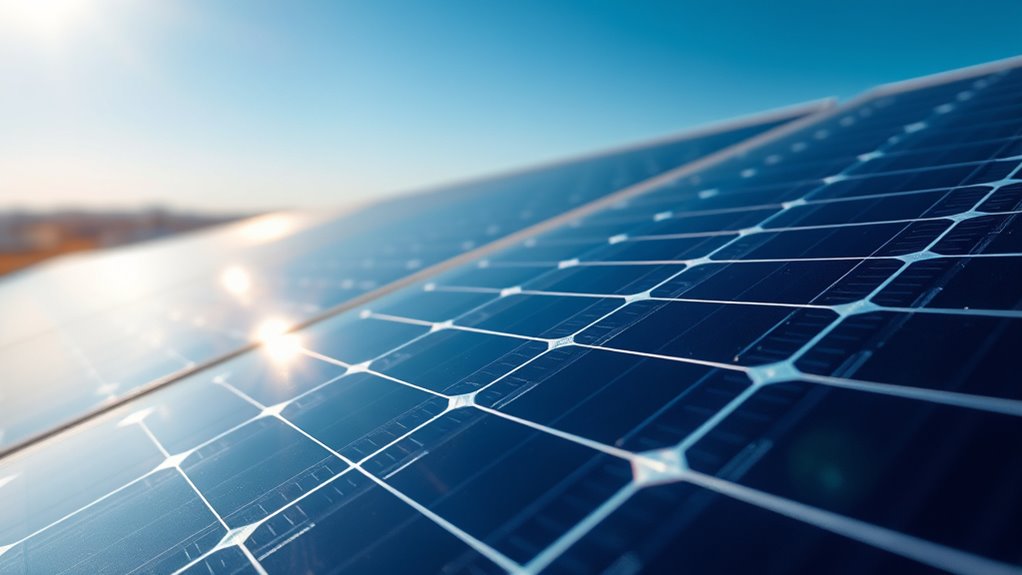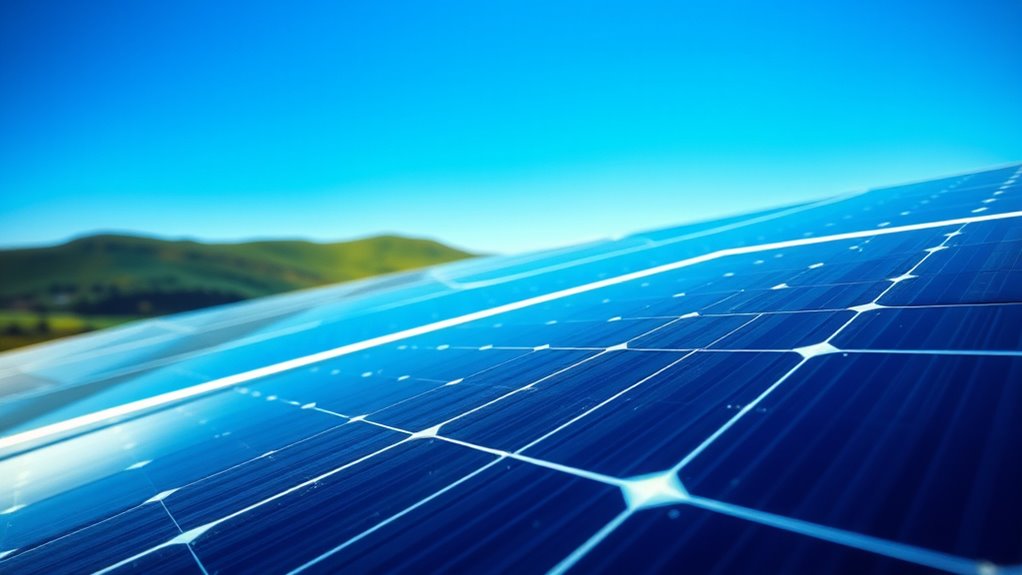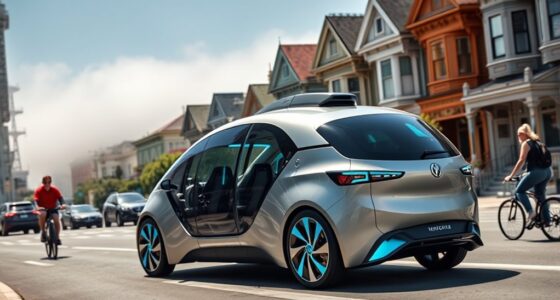Recent breakthroughs in solar cell efficiency mean you can expect cheaper green energy soon. As solar panels get better at converting sunlight into power, manufacturing costs drop, making these panels more affordable for homes and businesses. With government incentives and industry innovations, more people will adopt solar energy, accelerating its growth. These advancements are a significant step toward a cleaner, sustainable future — and there’s more to discover about how this progress unfolds.
Key Takeaways
- Recent efficiency breakthroughs enable more power generation from fewer solar panels, reducing overall system costs.
- Higher efficiency lowers manufacturing expenses, making solar energy more affordable and accessible.
- Advanced materials and scalable production techniques further decrease costs and boost large-scale adoption.
- Policy incentives and industry support accelerate market growth and technological deployment.
- Increased adoption of efficient solar technology promotes a transition to cleaner, greener, and more sustainable energy sources.

Recent advancements have pushed the boundaries of solar cell efficiency, setting new records that bring us closer to harnessing the sun’s full potential. These breakthroughs aren’t just scientific milestones; they have the power to transform the energy landscape, making solar power more accessible and affordable. As efficiency improves, the cost of producing solar panels is likely to decrease, which directly impacts manufacturing costs. Lower manufacturing costs mean that solar panels can be produced more cheaply at scale, paving the way for wider market adoption. When panels become more affordable, both residential and commercial sectors are more inclined to invest in solar energy, accelerating the transition away from fossil fuels.
Recent solar efficiency breakthroughs are making panels cheaper and more accessible, accelerating clean energy adoption worldwide.
You’ll find that these efficiency gains contribute substantially to reducing the overall cost per unit of energy generated. When solar cells convert sunlight into electricity more effectively, you get more power from the same amount of sunlight. This means fewer panels are needed to meet energy demands, which cuts down on installation and maintenance expenses. As a result, the upfront investment becomes less intimidating, encouraging more individuals, businesses, and governments to adopt solar solutions. This increased market adoption creates a positive feedback loop: higher demand spurs further innovations, driving down costs even more and improving efficiency continuously.
The push for higher efficiency also influences the manufacturing process itself. Advanced materials and manufacturing techniques are being developed to produce these new high-performance solar cells. These innovations often involve more sophisticated production methods, but as technology matures, economies of scale help bring down costs. Over time, the initial investment in new manufacturing equipment is offset by the savings in material and production expenses. As these high-efficiency solar cells become mainstream, mass production techniques will further reduce costs, making solar energy a viable option for a broader audience. Additionally, understanding bike maintenance and efficiency can serve as a useful analogy, emphasizing the importance of fine-tuning and optimizing systems for maximum performance. Incorporating advanced manufacturing techniques can further help lower production costs and improve scalability. Moreover, ongoing research in new materials continues to push the boundaries of what solar technology can achieve. These innovations are often supported by industry collaborations that facilitate technology transfer and scaling efforts. This progress is also supported by the development of sustainable manufacturing practices, which aim to reduce environmental impact and enhance cost-effectiveness.
You should also consider how government policies and incentives can accelerate market adoption. Subsidies, tax credits, and supportive regulations help mitigate the higher initial costs associated with new technology, making early adoption more appealing. As more consumers and companies see the long-term savings and environmental benefits, demand for these advanced solar cells is expected to rise sharply. This increased demand will likely prompt manufacturers to scale up production, further reducing costs and making solar power an even more attractive, cost-effective option.
In the end, these recent efficiency records mark a pivotal step toward cheaper, greener energy. They demonstrate that solar technology is evolving rapidly, with tangible benefits for both the economy and the environment. As manufacturing costs decline and market adoption grows, solar power is poised to become a dominant, sustainable energy source, bringing us closer to a cleaner, more energy-secure future.
Frequently Asked Questions
How Soon Will This New Solar Technology Be Commercially Available?
You’re likely wondering when this new solar technology will hit the market. Based on current market readiness and typical production timelines, you can expect it to become commercially available within the next 3 to 5 years. Manufacturers will need time to scale up production, perform rigorous testing, and navigate regulatory approvals. So, while promising, it’ll still take a few years before you start seeing this advanced solar tech in everyday energy solutions.
What Is the Environmental Impact of Manufacturing These Advanced Solar Cells?
Imagine you’re in a factory, like a modern-day assembly line, where manufacturing sustainability is key. You’ll notice that creating advanced solar cells involves recycling challenges, as some materials are tricky to reuse. While these cells promise cleaner energy, their production impacts the environment through resource extraction and waste. By focusing on eco-friendly practices, you can help reduce this footprint and support a greener future.
How Does This Efficiency Compare to Other Renewable Energy Sources?
You’ll find that solar power’s efficiency now surpasses many traditional renewable sources like wind or hydro, making it more competitive. Compared to other renewables, solar cells with higher efficiency convert more sunlight into electricity, boosting overall output. This renewable comparison shows solar’s rapid advancements, helping you realize it’s becoming a more reliable and cost-effective energy option. As efficiency improves, solar power’s role in sustainable energy grows markedly.
Will This Breakthrough Reduce Overall Solar Energy Costs Significantly?
This breakthrough could be a game-changer, like opening a treasure chest of energy affordability. You’ll likely see a significant cost reduction in solar energy, making it more accessible and affordable for everyone. As efficiency improves, the price to harness the sun’s power drops, helping you save money and reduce reliance on fossil fuels. This innovation brings us closer to a future where clean energy isn’t just a dream, but a reality you can embrace.
Are There Any Limitations or Challenges to Scaling up This Technology?
You might wonder about scalability challenges and material scarcity when expanding this new solar technology. While it promises higher efficiency, scaling up could face hurdles like limited availability of certain rare materials, which may increase costs or slow production. Additionally, manufacturing processes need to adapt to larger volumes, and environmental impacts of material extraction could pose further challenges. Addressing these issues is vital to making widespread, affordable green energy a reality.
Conclusion
With this new efficiency record, you’re stepping into a brighter, greener future. It’s a game changer that can make clean energy more affordable and accessible, helping you do your part for the planet. Don’t count your chickens before they hatch, but this breakthrough shows great promise. The road ahead is clear, and now’s the time to seize the moment—because when innovation leads, everyone wins in the long run.









